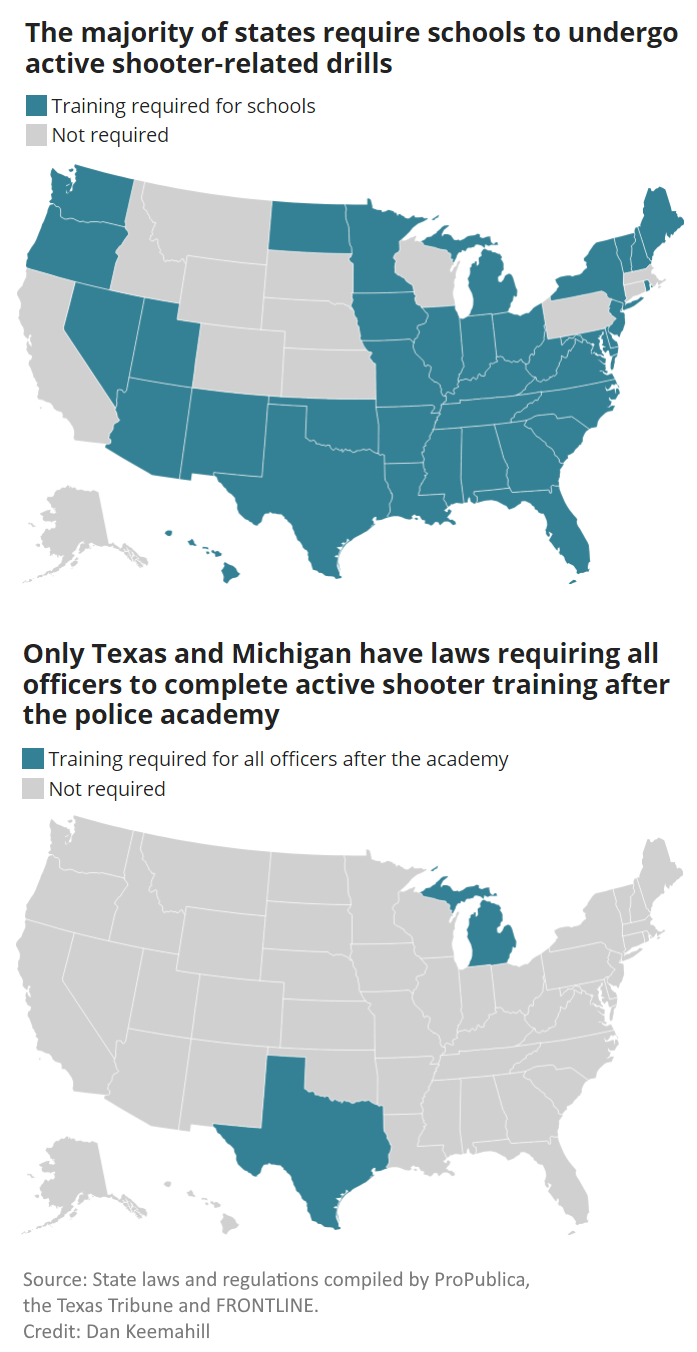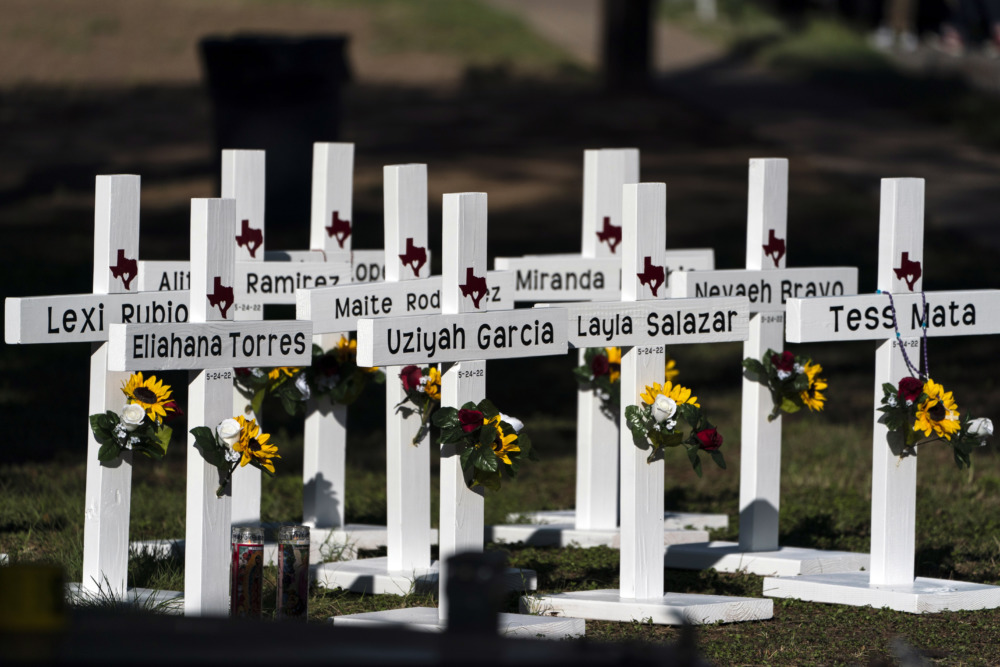After a teenage gunman killed 10 people at Santa Fe High School in 2018, Texas lawmakers mandated that all school police officers receive training to better prepare them for the possibility of confronting a mass shooter. The law, which required that such training occur only once, didn’t apply to thousands of state and local law enforcement officers who did not work in schools.
Four years later, officers who descended on Uvalde’s Robb Elementary School, a vast majority of whom were not school police, repeatedly acted in ways that ran contrary to what active shooter training teaches, waiting 77 minutes to engage the gunman. An investigation published in December by The Texas Tribune, ProPublica and FRONTLINE revealed that about 30% of the 116 state and local officers who responded in May 2022 did not get active shooter training after graduating from police academies. Of those who had, many received such instruction only once in their careers, which at least eight police training experts say is not enough.
Only two states — Texas and Michigan — have laws that require active shooter training for all officers once on the job.
As part of the investigation, the news organizations conducted a nationwide analysis to examine active shooter training requirements and found critical gaps in preparedness between children and law enforcement. While at least 37 states require active shooter-related drills in schools, typically on a yearly basis, no states mandate such training for officers annually.
Instead, decisions about active shooter training are often left to individual school districts and law enforcement departments, creating a patchwork approach in which some proactively provide such instruction and others do not.
The month after the news organizations’ investigation was published, U.S. Attorney General Merrick Garland’s office released a scathing report that detailed a slew of failures during the Robb Elementary response. While visiting Uvalde, he told reporters that law enforcement agencies should immediately prioritize active shooter training.
The federal report recommended that officers receive eight hours of such instruction annually. Only Texas, however, comes close to meeting the Department of Justice’s suggested standards, according to the newsrooms’ nationwide analysis. Last year, the state mandated that all officers, not just school police, take 16 hours of active shooter training every two years.
13 states don’t require active shooter-related drills in schools.
About a dozen states also increased training requirements after the Uvalde shooting, but many continue to fall short of what police training experts say is needed.
The gaps in training requirements begin before officers’ first day on the job.
While police academies in nearly every state require some form of active shooter training, five states — California, Georgia, Ohio, Washington and Vermont — do not require it for all recruits. A spokesperson for the police standards agency in Washington did not respond to a request for comment. A spokesperson for the Vermont police standards agency said the police academy curriculum is being reviewed but she could not comment on whether it will expand active shooter training to all officers. Officials with police standards agencies in the other three states said they are considering adding active shooter training to their police academy curriculum.

Find additional information in a searchable database that accompanies this story →
Once officers graduate from police academies, the lack of training requirements becomes more pronounced.
Only two states — Texas and Michigan — have laws that require active shooter training for all officers once on the job. While Texas requires recurring instruction, training in Michigan is given once after officers graduate from police academies. Some states mandate active shooter training one time in a particular year, leaving out officers who were not employed at the time. Other states require training only for school police, as Texas did before the Uvalde shooting, and only two of them — Illinois and Mississippi — require it more than once.
[Related: Someone tell me what to do]
While a majority of states require frequent active shooter-related drills in schools, 13 don’t require such instruction. They include Colorado and Connecticut, which had two of the worst mass shootings in history: the 1999 Columbine school massacre and the 2012 shooting at Sandy Hook Elementary. Spokespeople for the school safety departments in both states said districts are conducting drills despite the absence of a state mandate but did not provide records that confirm their assertions.
[Related: Uvalde families plead for languishing Texas gun bills]
Active shooter training can be expensive, but state lawmakers should commit to providing the necessary instruction if they want law enforcement to be better prepared for a mass shooting, police training experts said. John Curnutt, assistant director at Texas State University’s Advanced Law Enforcement Rapid Response Training Center, said Uvalde is a “horrible example” of when training was needed but hadn’t been practiced enough.
“There’s a higher price that’s paid than the one that we probably could have paid upfront to get ready for it,” Curnutt said.
![]()
About this research
To confirm the most up-to-date active shooter training requirements for law enforcement and schools across the country as of 2023, we contacted education departments and law enforcement standards agencies in every state. We examined both state laws and regulations.
In our analysis of schools, we included all mandated lockdown and active shooter drills, though some education departments said other types of drills can help prepare students and staff as well. In addition to the 37 states that explicitly require active shooter-related drills, we noted several others that have laws mandating safety drills but allow districts to decide which types of drills to conduct. We did not include those in our total count because the options could range from active shooter drills to earthquake drills.
For law enforcement, we collected information about how many hours of active shooter training are required for recruits going through police academies and for officers once they are on the job. We also asked for statewide data showing how many officers had taken such courses, but few states could provide that information. While we included only states’ current training mandates, four states — Alabama, North Carolina, Maine and Pennsylvania — required officers to train in a particular year but then not again, meaning that only those who were employed at that time received the one-time instruction.
***
Lexi Churchill is a research reporter with the ProPublica-Texas Tribune investigative unit. Before joining ProPublica, Lexi interned at several organizations, including CNBC and the St. Louis Post-Dispatch.
Lomi Kriel is an award-winning reporter with the ProPublica-Texas Tribune investigative unit. Previously she was a reporter at the Houston Chronicle covering immigration, often focused on the Texas border.
This article originally appeared in The Texas Tribune, a member-supported, nonpartisan newsroom.
This article is co-published with ProPublica, a nonprofit newsroom that investigates abuses of power. Sign up for ProPublica’s Big Story newsletter
